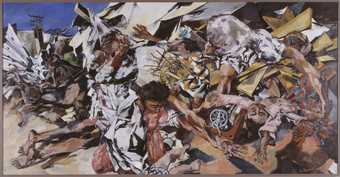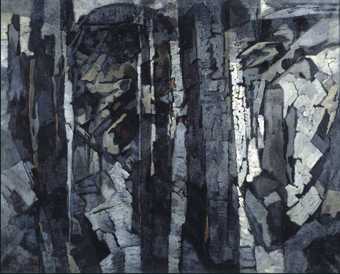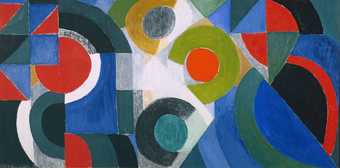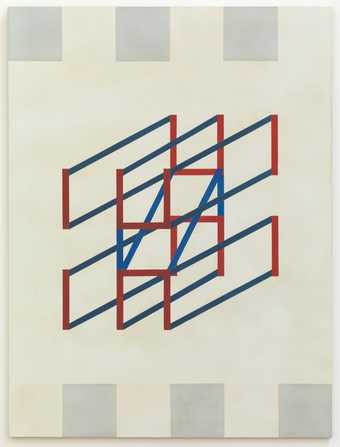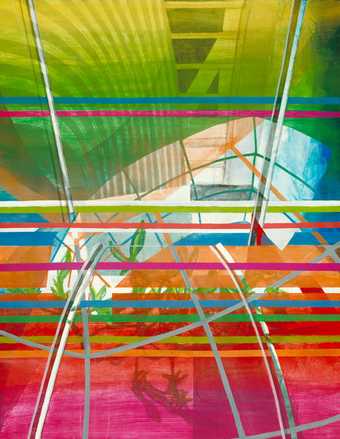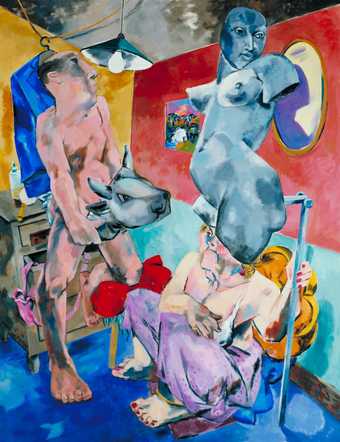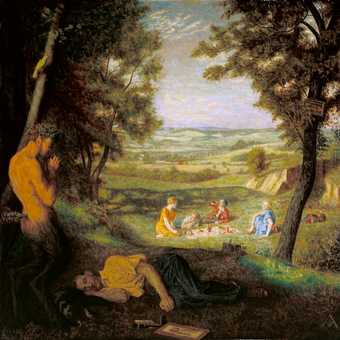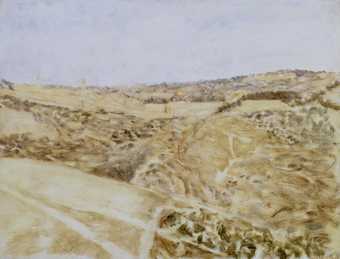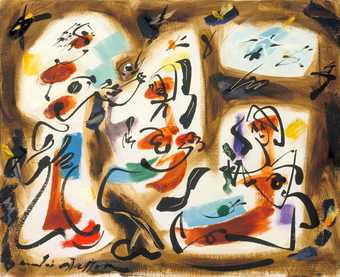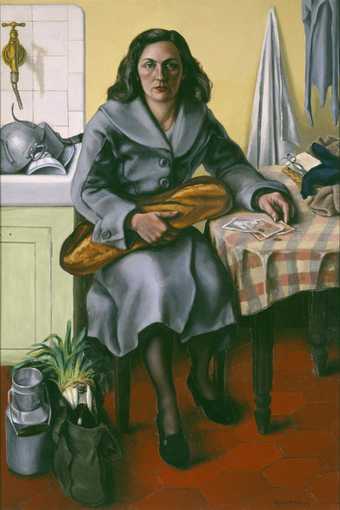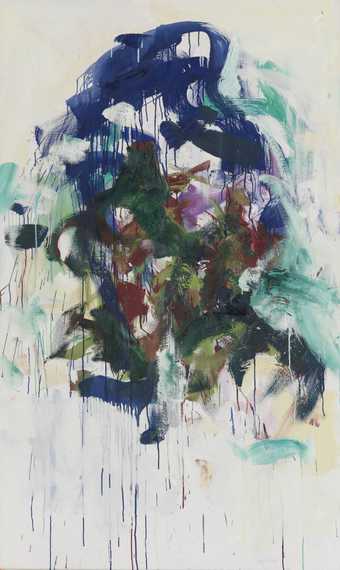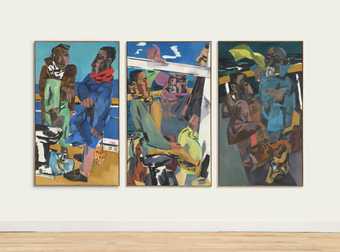
Not on display
- Artist
- George Warner Allen 1916–1988
- Medium
- Oil paint and tempera on canvas
- Dimensions
- Support: 1165 × 1270 mm
- Collection
- Tate
- Acquisition
- Purchased 1992
- Reference
- T06610
Summary
Allen painted two versions of The Return from Cythera, of which this is the second. He decided to paint a second version because he felt the first, painted in 1975-7, was too small for the subject matter and that the trees lacked the appropriate tonality. In keeping with his lifelong practice, he used highly traditional techniques to paint the picture, which included grinding his own paint and applying thin oil glazes to tempera underpainting to enhance colour and form. The strong colour contrasts and the chromatic intensity of the painting are hallmarks of his later work. As with most of his landscape paintings it depicts the countryside near his home in Wallingford, Oxfordshire, where the picture was painted. Indeed, in the far distance the cooling towers of Didcot power station are visible, a structure Allen loathed and which he associated with the technological and commercial nature of the modern world.
The title and some of the imagery of the painting are derived from Jean-Antoine Watteau's (1684-1721) Embarkation for Cythera. Of the three pictures with this title that Watteau painted, The Return from Cythera shares most in terms of composition with the version in the Louvre, Paris, c.1717. In Greek mythology Cythera was the birthplace of Aphrodite, goddess of erotic love, beauty and fertility, and was thus associated with these themes. Watteau's painting, which is full of references to sexual desire, depicts a group of noble men and women setting out on a journey to Cythera; Allen's shows the return. The figures, who are still in Cythera, appear to be preparing to leave. In the foreground on the right a woman is packing up the picnic basket. Next to her a young woman is putting a dress on. In the middle distance a man and a woman seem to be walking down towards the river, a natural boundary that perhaps serves to demarcate the ideal and mundane worlds. Exactly what the group have been doing is not clear, but the naked and semi-naked figures, presided over by the statue of Aphrodite modestly covering herself, give the scene an appropriately erotic charge.
Allen's painting is also closely related to Titian's (c.1487-1576) Bacchus and Ariadne (National Gallery, London), as is Watteau's. In Titian's painting Bacchus, in a chariot drawn by two cheetahs, emerges with his followers from woods on the right of the picture. On the left, against an open landscape that stretches into the far distance, stands Ariadne, startled by their sudden appearance. The sky and the figures are all rendered in exceptionally brilliant colours. Titian's use of colour was partly informed by Renaissance symbolism; for example, blue, found predominantly in the sky and dress of Ariadne, often signified the divine or cosmic, while red, used in the clothing of Bacchus's entourage, denoted the flesh. While Watteau's painting refers obliquely to Bacchus and Ariadne through the incorporation of various motifs associated with it, Allen's borrows the basic composition of Titian's painting and emulates its palette.
Further reading
John Christian (ed.), The Last Romantics: The Romantic Tradition in British Art, exhibition catalogue, Barbican Art Gallery, London 1989, p.197
David Mellor (ed.), A Paradise Lost: The Neo-Romantic Imagination in Britain 1935-55, exhibition catalogue, Barbican Art Gallery, London 1987, p.143
Toby Treves
January 2001
Does this text contain inaccurate information or language that you feel we should improve or change? We would like to hear from you.
Display caption
'The Return from Cythera' is the second of Allen's two versions of this subject. The work depicts a picnic at the moment when, as day draws to a close, the group of friends realise that they must return home. The picture is set in the Oxfordshire countryside which Allen loved and where he lived. But in the distance is the image of the cooling towers of the power station at Didcot, which Allen disliked. The figures are thus caught between an imaginative, pastoral idyll and the problems of the modern industrial world. The title and some of the work's imagery were inspired by Watteau but the painting was intended more as a tribute to Titian.
Gallery label, September 2004
Does this text contain inaccurate information or language that you feel we should improve or change? We would like to hear from you.
Technique and condition
The painting is in tempera and oil colours on gesso primed linen, prepared by the artist.
Fine linen canvas is stretched over a stretcher, sized and primed with a water soluble gesso. The gesso retains some of the canvas texture and feint brushstrokes from its application. In some areas it has penetrated through the canvas forming small nodules at the back.
The painting process closely resembles that used by Allen for 'Picnic at Wittenham' (see T06604) painted some eighteen years before. An intricately developed underpainting is glazed over with highly resinous, translucent oil colours, the effect is less atmospheric than 'Picnic and Wittenham'. 'The Return from Cythera' has more strongly differentiated local colours and detailing of forms in the oil glazes and scumbles and less merging of forms.
The painting and its original ornate moulded frame, which was fitted in c.1987, are in good condition. Only minor improvements to the fitting of the painting and glass were required on acquisition.
Roy Perry
1996
Explore
- architecture(30,960)
-
- industrial(2,075)
-
- cooling tower(15)
- power station(9)
- monuments(1,376)
-
- statue(334)
- townscapes / man-made features(21,603)
-
- path(385)
- emotions and human qualities(5,345)
-
- love(516)
- eating and drinking(409)
-
- picnic(67)
- domestic(414)
- actions: expressive(2,622)
-
- leaving(20)
- countries and continents(17,390)
-
- Greece(85)
- Greece, Cythera(2)
- Cythera(2)
- Didcot(1)
- Oxfordshire(1,239)
- England(19,202)
- England, South East(5,940)
- England, Southern(8,982)
- sex and relationships(833)
-
- couple(1,322)
- eroticism(409)
- flirtation(45)
- friendship(1,628)
- industrial society(425)
You might like
-
Peter de Francia The Bombing of Sakiet
1959 -
Claude Bellegarde Bird I
1957 -
Pierre Dimitrienko The Petrified Forest
1956 -
Sonia Delaunay Triptych
1963 -
Gillian Wise Looped Network Suspended in Pictorial Space
1974 -
Stanley William Hayter Teatro Olimpico
1980 -
Jean Dubuffet Vicissitudes
1977 -
Peter de Francia Disparates (Omnia Vincit Amor)
1977 -
George Warner Allen Picnic at Wittenham
1947–8 -
Avigdor Arikha Jerusalem Seen from the South
1980 -
André Masson Kitchen-maids
1962 -
André Fougeron Return from the Market
1953 -
André Fougeron Massacre at Sakiet III
1958 -
Joan Mitchell Chord II
1986 -
Peter de Francia The Emigrants
1964–6

